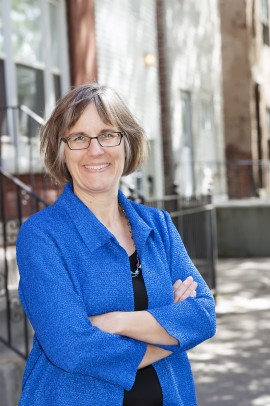Racial integration, location and neighborhoods

Sociology professor Maria Krysan studies racial integration in neighborhoods. “Whites may not move into a neighborhood with more than a few blacks,” she says. “And blacks may not want to move into a neighborhood where they are afraid of how they may be treated.” Photo: Roberta Dupuis-Devlin
Maria Krysan reminds us that it’s all about location, location, location.
“So much of what happens to you in life depends on where you live,” she said.
Are the schools good? Are home values on the rise? What about crime? Also — and this is where Krysan comes in — is the neighborhood racially integrated?
That’s important because “residential segregation has been called the structural linchpin of racial inequality,” said Krysan, professor of sociology.
“My interest is in what causes these patterns of segregation. Researchers refer to the ‘Big 3’ causes of residential segregation.”
They are, she said:
- discrimination: blacks, whites and Latinos are treated differently when they look for a place to live
- income
- preferences: some people prefer to live in segregated neighborhoods.
“The foundation of preferences could be prejudice,” Krysan said.
“Whites may not move into a neighborhood with more than a few blacks. And blacks may not want to move into a neighborhood where they are afraid of how they may be treated.”
As for preferences, if what motivates them is a desire to live among one’s “own kind,” then “there is no problem to solve,” she said.
“A part of my work is unpacking preferences to show what is at the root.”
Some whites say it’s not that they have anything against blacks, but they dislike the social-class characteristics of neighborhoods they imagine African Americans live in.
“There’s a race-class debate,” Krysan said.
“The popular perception is that racial attitudes have changed, it’s no longer legal to discriminate and there is a growing black middle class,” she noted.
As a result, some think that African Americans in all-black neighborhoods live there because they want to.
“But my research shows that African Americans prefer diverse neighborhoods, and the desire to avoid all-white neighborhoods is due to not wanting to be discriminated against, or to be blamed or harassed if anything goes wrong in the neighborhood,” Krysan said.
Her most recent research suggests that the “Big 3” is too narrow, that “it’s not a good enough explanation of why we continue to live in separate neighborhoods,” she said. “Other factors are driving segregation.”
One such factor is how much one knows about various Chicago neighborhoods or suburbs.
“It’s hard to move to a place if you’ve never heard of it,” she said.
For one study she designed, Krysan showed participants a map of 41 Chicago-area communities.
“Whites were more likely to know about white communities, and blacks knew more about black communities — that’s not rocket science,” she said.
But whites were less likely to know about integrated neighborhoods like Beverly and Homewood-Flossmoor.
Blacks, for their part, were less likely to have heard of Libertyville and Crystal Lake.
Krysan is also director of the Chicago Area Study.
“This is an initiative with three main goals: one, collect data and do basic research on urban issues in the Chicago metropolitan area; two, do policy-relevant research on pressing issues; and three, train graduate students in social science research methods,” Krysan said.
Guided by faculty investigators, the grad students help design and execute research surveys.
The research subjects are something “the world would care about, not just other professors,” she said. In one recent study, child care directors were interviewed on the question: “What is high-quality child care?”
Krysan was raised in Brookings, S.D. She earned a bachelor’s degree at Stanford, then worked as a research assistant for a nonprofit in Washington, D.C., for two years.
At the University of Michigan she received a master’s and Ph.D. She taught at Pennsylvania State University for four years before joining UIC in 2000.
She bakes cakes, pies and cookies for sociology department functions.
“I haven’t mastered bread,” she admitted.
Krysan lives with her 6-year-old daughter, Katerina, in Chicago’s Galewood neighborhood, across the street from Oak Park.
“Yes, Galewood is an integrated community,” she said.
“Whites, African Americans and Latinos are the three largest groups, and there are significant numbers of all three.”
